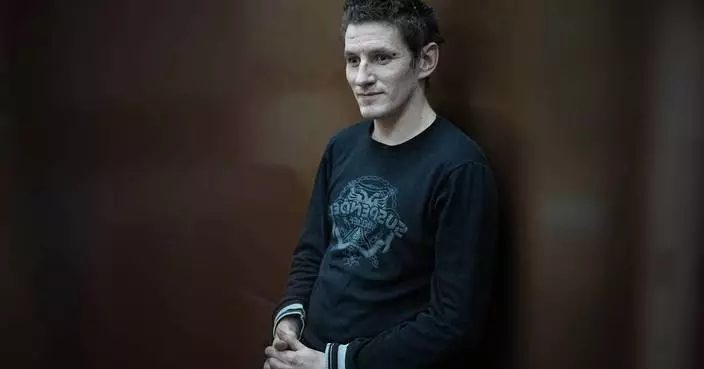Civil liberties groups on Wednesday asked for a temporary restraining order blocking the Trump administration's effort to effectively end asylum at the U.S.-Mexico border.
The American Civil Liberties Union and others filed the request seeking a Thursday hearing in San Francisco. The groups sued Tuesday and want the judge to block the policy while the case is heard. A second lawsuit is pending in Washington, D.C.
Hundreds of immigrants have showed up at border crossings in hopes of getting into the U.S. But the new rules that went into effect earlier this week bar most migrants from seeking protection as refugees if they have passed through another country first. It targets tens of thousands of Central Americans who cross into the U.S. through Mexico, but also affects people from Africa, Asia, and South America who come to the southern border.

Guatemalan men who were deported from the United States, leave the Air Force Base after arriving in Guatemala City, Tuesday, July 16, 2019. Nearly 200 Guatemalan migrants have been deported on Tuesday, the day the Trump administration planned to launch a drastic policy change designed to end asylum protections for most migrants who travel through another country to reach the United States. (AP PhotoMoises Castillo)
It was the most forceful attempt to date by President Donald Trump to slash the number of people seeking asylum in America. It comes at a time when Trump's recent tweets telling four members of Congress to "go back" to other countries have set off an uproar.
U.S. officials have said the plan would discourage migrants from leaving their countries, which is necessary to reduce the numbers of people border agents are detaining.
There are some exceptions: If someone has been trafficked, if the country the migrant passed through did not sign one of the major international treaties that govern how refugees are managed (though most Western countries have signed them) or if an asylum-seeker sought protection in a country but was denied — then a migrant could still apply for U.S. asylum.
But immigration advocates say the Trump administration's action is illegal because it circumvents the process Congress has established for asylum. They compared it to the Trump administration's earlier attempts to ban anyone crossing the southern border illegally from seeking asylum, which a federal court stopped.
U.S. asylum law allows refugees to request asylum when they arrive regardless of how they did so, but there is an exception for those who have come through a country considered to be "safe."
At the northern border, the U.S. and Canada have a "safe third country" agreement that limits people who arrive in one country from seeking asylum in the other. The U.S. has sought to reach the same agreement with Mexico and Guatemala, but nothing has been decided.
The Trump administration's treatment of Central American migrants has come under heavy criticism as border officials manage record numbers of people crossing the border. Advocates and Democratic lawmakers have reported fetid conditions in overcrowded border facilities, with children trying to care for themselves and images of packed cells where some detainees don't have room to sleep.
Associated Press Writer Nomaan Merchant contributed to this report from Houston.
VENICE. Italy (AP) — Jeffrey Gibson’s takeover of the U.S. pavilion for this year’s Venice Biennale contemporary art show is a celebration of color, pattern and craft, which is immediately evident on approaching the bright red facade decorated by a colorful clash of geometry and a foreground dominated by a riot of gigantic red podiums.
Gibson, a Mississippi Choctaw with Cherokee descent, is the first Native American to represent the United States solo at the Venice Biennale, the world’s oldest contemporary art show. For context, the last time Native American artists were included was in 1932.
Gibson, 52, accepts the weight of the honor, but he prefers to focus on how his participation can forge greater inclusion going forward.
“The first is not the most important story," Gibson told The Associated Press this week before the pavilion’s inauguration on Thursday. “The first is hopefully the beginning of many, many, many more stories to come."
The commission, his first major show in Europe, comes at a pivotal moment for Gibson. His 2023 book “An Indigenous Present" features more than 60 Indigenous artists, and he has two major new projects, a facade commission for the Metropolitan Museum of Art in New York and an exhibition at the Massachusetts Museum of Contemporary Art.
Gibson’s eye-catching exhibition titled “the space in which to place me," features text in beadwork sculptures and paintings taken from U.S. founding documents, music, sermons and proverbs to remind the viewer of the broken promises of equity through U.S. history. The vibrant use of color projects optimism. In that way, Gibson’s art is a call to action.
“What I find so beautiful about Jeffrey’s work is its ability to function as a prism, to take the traumas of the past and the questions about identity and politics and refract them in such a way that things that realities that have become flattened … can become these beautiful kaleidoscopes, which are joyous and celebratory and critical all at the same time," said Abigail Winograd, one of the exhibition’s curators.
“When I see people walk through the pavilion and kind of gasp when they walk from room to room, that’s exactly what we wanted," Winograd said.
Entering the pavilion, the beaded bodices of sculptures in human form are emblazoned with dates of U.S. legislation that promised equity, the beading cascading into colorful fringe. A painting quotes George Washington writing, “Liberty, when it begins to take root, is a plant of rapid growth," in geometric letters that meld into a colorful patterned background.
By identifying specific moments in U.S. history, Gibson said that he wants to underline that “people who are fighting for equity and justice today, we’re not the first.
“This has been a line in the history of American culture. But I’m hoping that people will think about why … some of these things … have either been revoked or have not come into fruition,” he said.
Craft is at the center of Gibson’s art, both in defiance of past denigration of craft and as a way to confront “the traumatic histories of Native American people,” he said.
“There is something very healing about the cycle of making," Gibson explained.
The pavilion’s intricate beaded sculptures owe a debt to Native American makers of the past without imitating them, employing couture techniques to create something completely new. In the way of his forbears, Gibson uses beads sourced from all over the world, including vintage beads from Japan and China, and glass beads from the Venetian island of Murano.
Paper works incorporate vintage beadwork purchased from websites, estate and garage sales in mixed media displays that honor the generations of Native American makers that preceded him.
Gibson's themes fit well into the message of inclusion of the main Biennale exhibition, titled “Stranieri Ovunque -- Strangers Everywhere,” which runs in tandem with around 90 national pavilions from April 20-Nov. 24.
His personal history has placed him firmly in what he calls the “diasporic history of Indigenous people.” His father's job took his family abroad when he was a child to Germany and then South Korea, and he later studied in Chicago and London. His partner is Norwegian artist Rune Olsen.
Through all of this, Gibson has picked up traditions and practices that go beyond his Indigenous background.
“I’ve looked at op art, pattern and decoration. I've looked at psychedelia, I have taken part in rave culture and queer culture and drag and the whole spectrum," Gibson said.
"And so for me, I would not be telling you the whole truth if I only chose to spoke about indigeneity. But my body is an Indigenous body — it’s all funneled through this body,'' he said. ”And so my hope is that by telling my experience, that everyone else can project their own kind of intersected, layered experience into the world.”
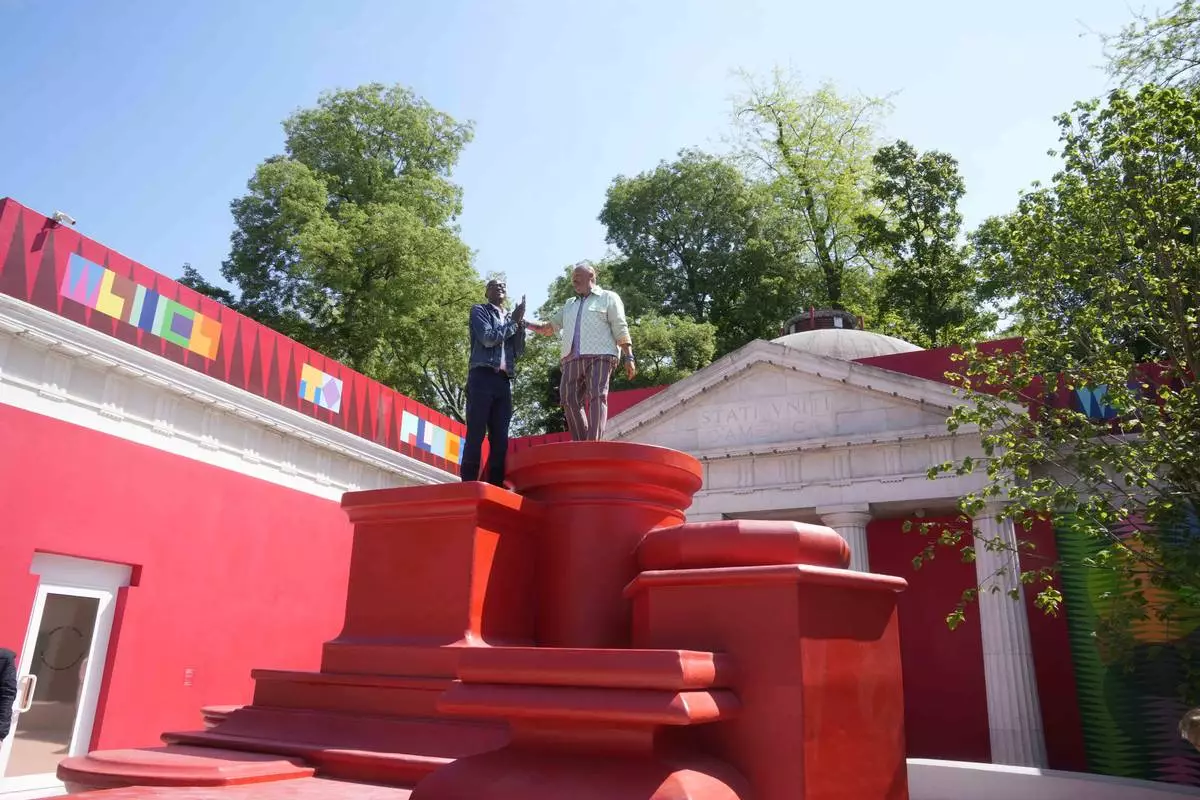
Artist Jeffrey Gibson, right, poses with artist Mark Bradford at the U.S. pavilion during the media open day at the 60th Biennale of Arts in Venice, Italy, Tuesday, April 16, 2024. A Mississippi Choctaw of Cherokee descent, Gibson is the first Native American to represent the United States solo at the Venice Biennale, the world’s oldest contemporary art show. Gibson mixes Western modernism and Native American craft in his vibrantly hued paintings and sculptures. (AP Photo/Luca Bruno)
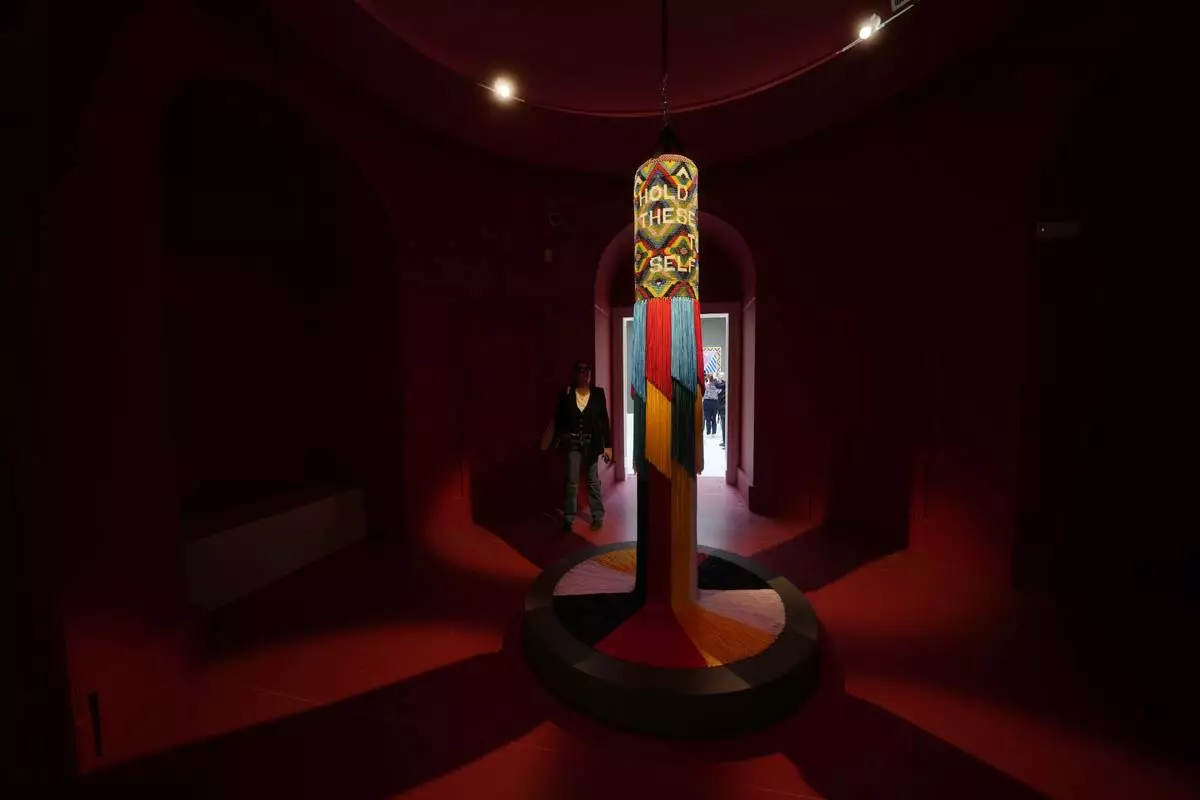
Visitors look at sculptures on display inside the US pavilion by artist Jeffrey Gibson during the 60th Biennale of Arts in Venice, Italy, Tuesday, April 16, 2024. A Mississippi Choctaw of Cherokee descent, Gibson is the first Native American to represent the United States solo at the Venice Biennale, the world’s oldest contemporary art show. Gibson mixes Western modernism and Native American craft in his vibrantly hued paintings and sculptures. (AP Photo/Luca Bruno)
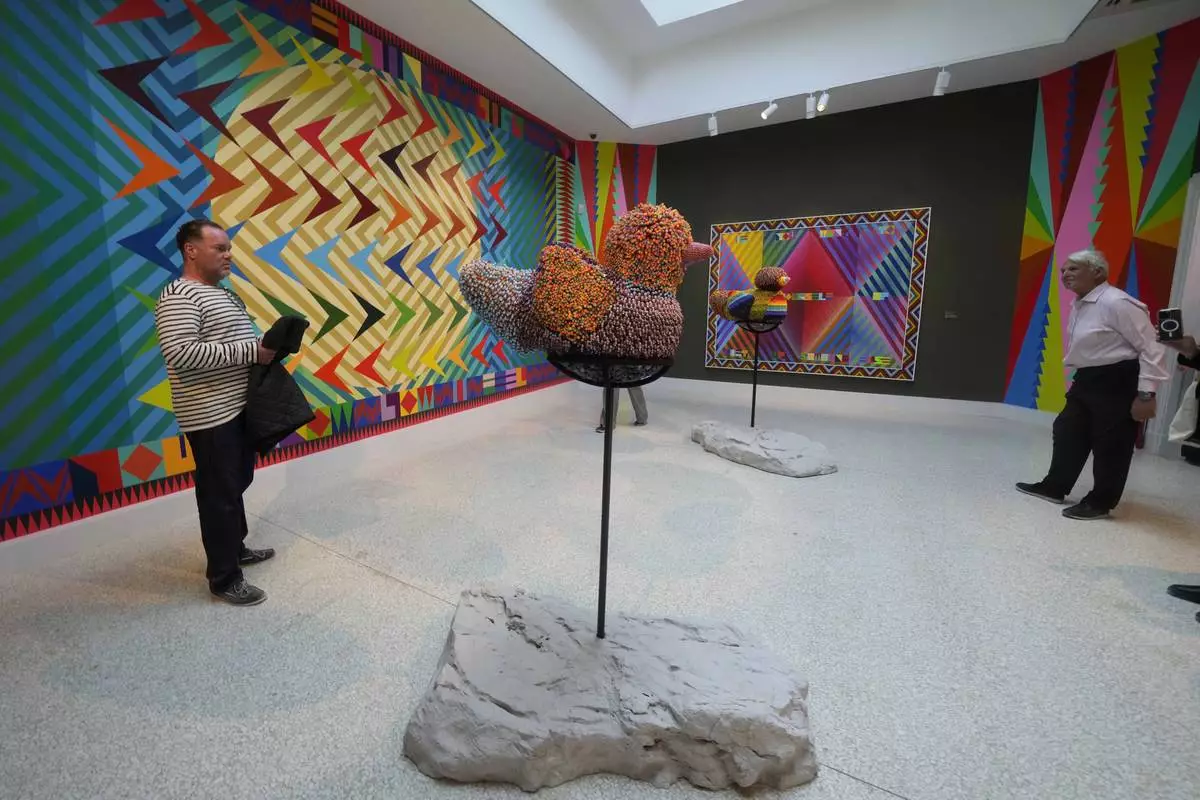
Visitors look at sculptures on display inside the US pavilion by artist Jeffrey Gibson during the 60th Biennale of Arts in Venice, Italy, Tuesday, April 16, 2024. A Mississippi Choctaw of Cherokee descent, Gibson is the first Native American to represent the United States solo at the Venice Biennale, the world’s oldest contemporary art show. Gibson mixes Western modernism and Native American craft in his vibrantly hued paintings and sculptures. (AP Photo/Luca Bruno)

Visitors look at sculptures on display inside the US pavilion by artist Jeffrey Gibson during the 60th Biennale of Arts in Venice, Italy, Tuesday, April 16, 2024. A Mississippi Choctaw of Cherokee descent, Gibson is the first Native American to represent the United States solo at the Venice Biennale, the world’s oldest contemporary art show. Gibson mixes Western modernism and Native American craft in his vibrantly hued paintings and sculptures. (AP Photo/Luca Bruno)

Visitors look at sculptures on display inside the US pavilion by artist Jeffrey Gibson during the 60th Biennale of Arts in Venice, Italy, Tuesday, April 16, 2024. A Mississippi Choctaw of Cherokee descent, Gibson is the first Native American to represent the United States solo at the Venice Biennale, the world’s oldest contemporary art show. Gibson mixes Western modernism and Native American craft in his vibrantly hued paintings and sculptures. (AP Photo/Luca Bruno)
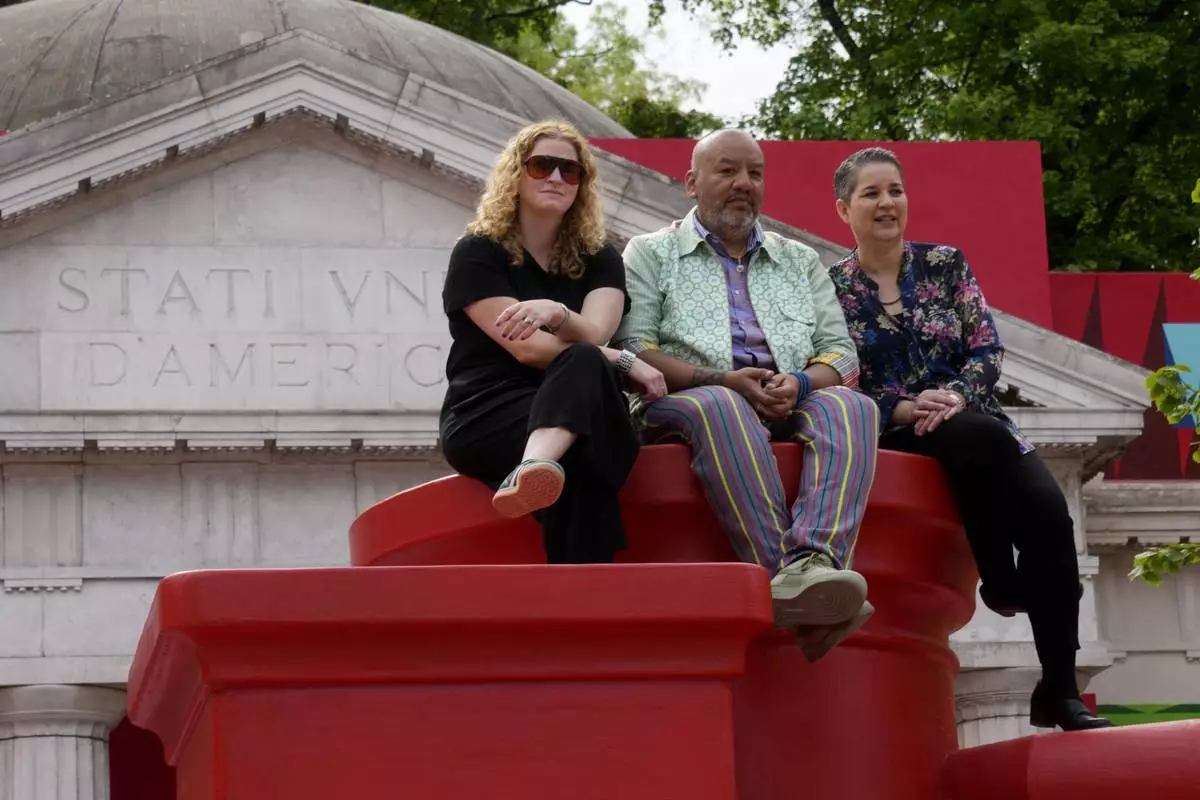
From left, Curator Abigail Winograd, artist Jeffrey Gibson, and Curator Kathleen Ash-Milby pose at the US pavilion during the media open day at the 60th Biennale of Arts in Venice, Italy, Tuesday, April 16, 2024. A Mississippi Choctaw of Cherokee descent, Gibson is the first Native American to represent the United States solo at the Venice Biennale, the world’s oldest contemporary art show. Gibson mixes Western modernism and Native American craft in his vibrantly hued paintings and sculptures. (AP Photo/Luca Bruno)
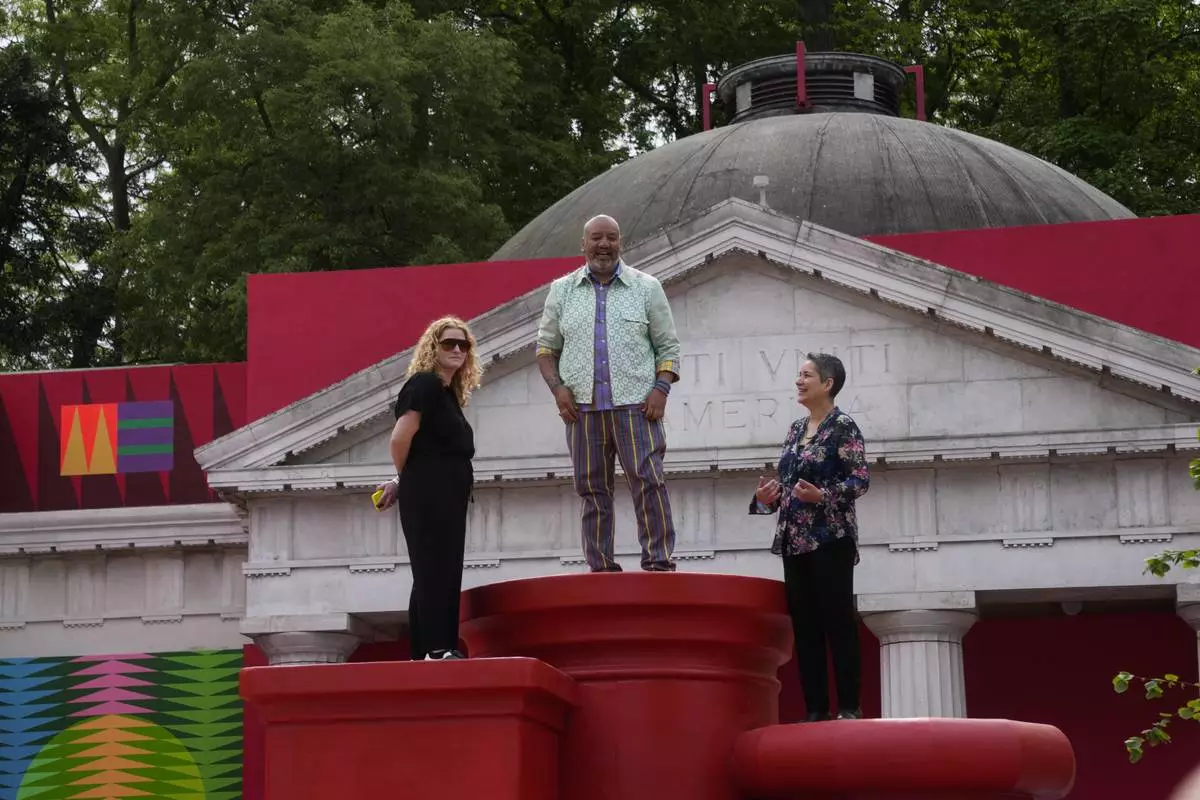
From left, Curator Abigail Winograd, artist Jeffrey Gibson, and Curator Kathleen Ash-Milby pose at the US pavilion during the media open day at the 60th Biennale of Arts in Venice, Italy, Tuesday, April 16, 2024. A Mississippi Choctaw of Cherokee descent, Gibson is the first Native American to represent the United States solo at the Venice Biennale, the world’s oldest contemporary art show. Gibson mixes Western modernism and Native American craft in his vibrantly hued paintings and sculptures. (AP Photo/Luca Bruno)
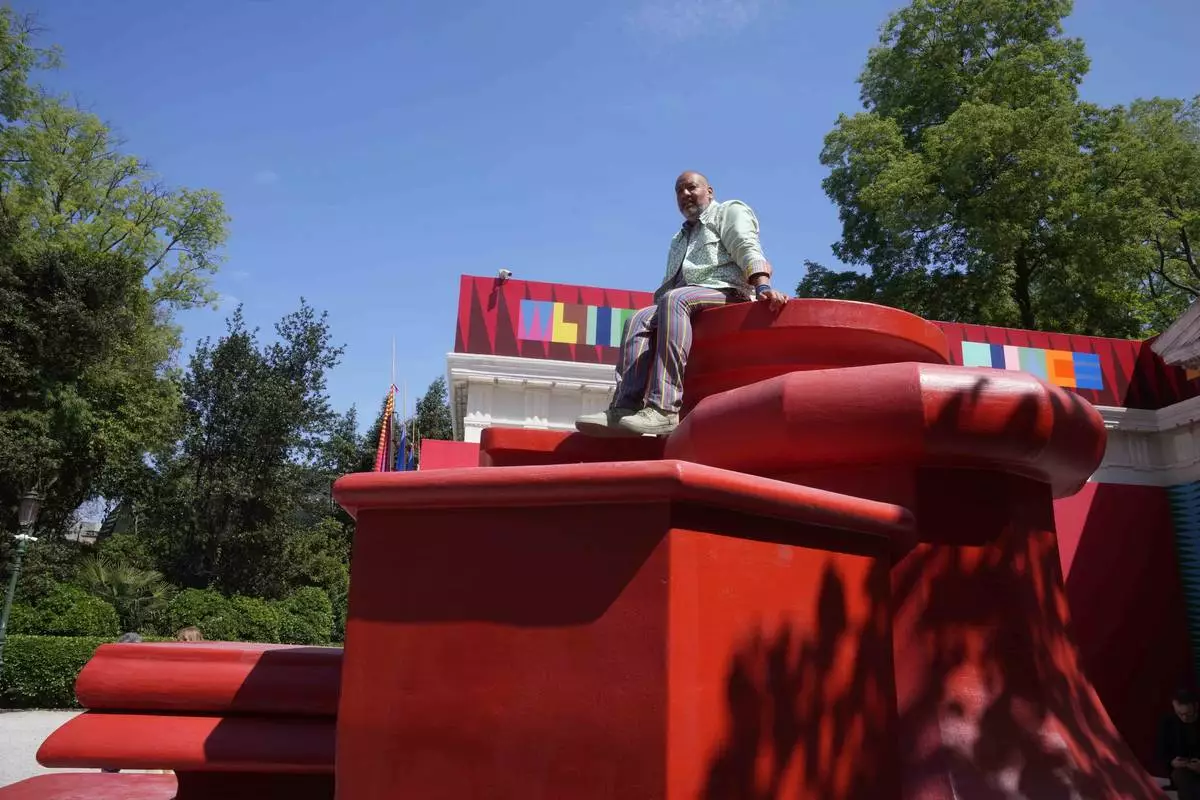
Artist Jeffrey Gibson poses at the US pavilion during a media open day at the 60th Biennale of Arts in Venice, Italy, Tuesday, April 16, 2024. A Mississippi Choctaw of Cherokee descent, Gibson is the first Native American to represent the United States solo at the Venice Biennale, the world’s oldest contemporary art show. Gibson mixes Western modernism and Native American craft in his vibrantly hued paintings and sculptures. (AP Photo/Luca Bruno)
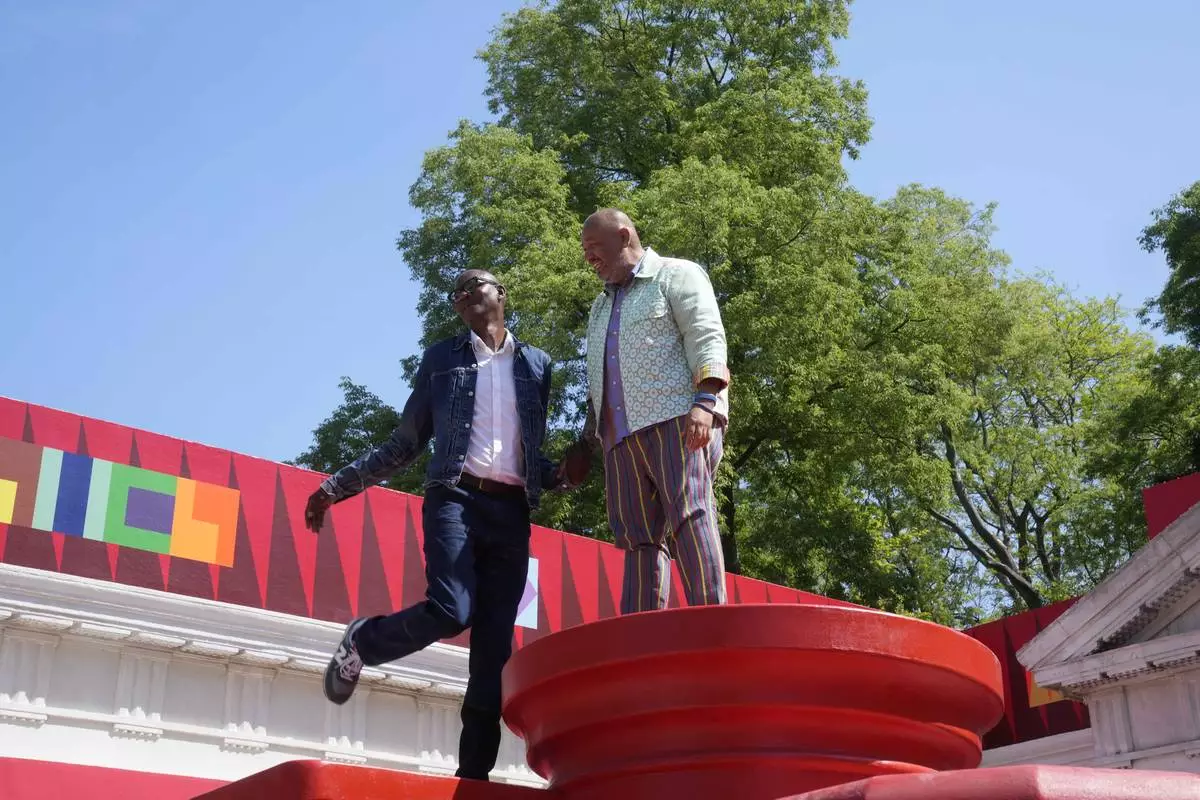
Artist Jeffrey Gibson, right, poses with artist Mark Bradford at the U.S. pavilion during the media open day at the 60th Biennale of Arts in Venice, Italy, Tuesday, April 16, 2024. A Mississippi Choctaw of Cherokee descent, Gibson is the first Native American to represent the United States solo at the Venice Biennale, the world’s oldest contemporary art show. Gibson mixes Western modernism and Native American craft in his vibrantly hued paintings and sculptures. (AP Photo/Luca Bruno)
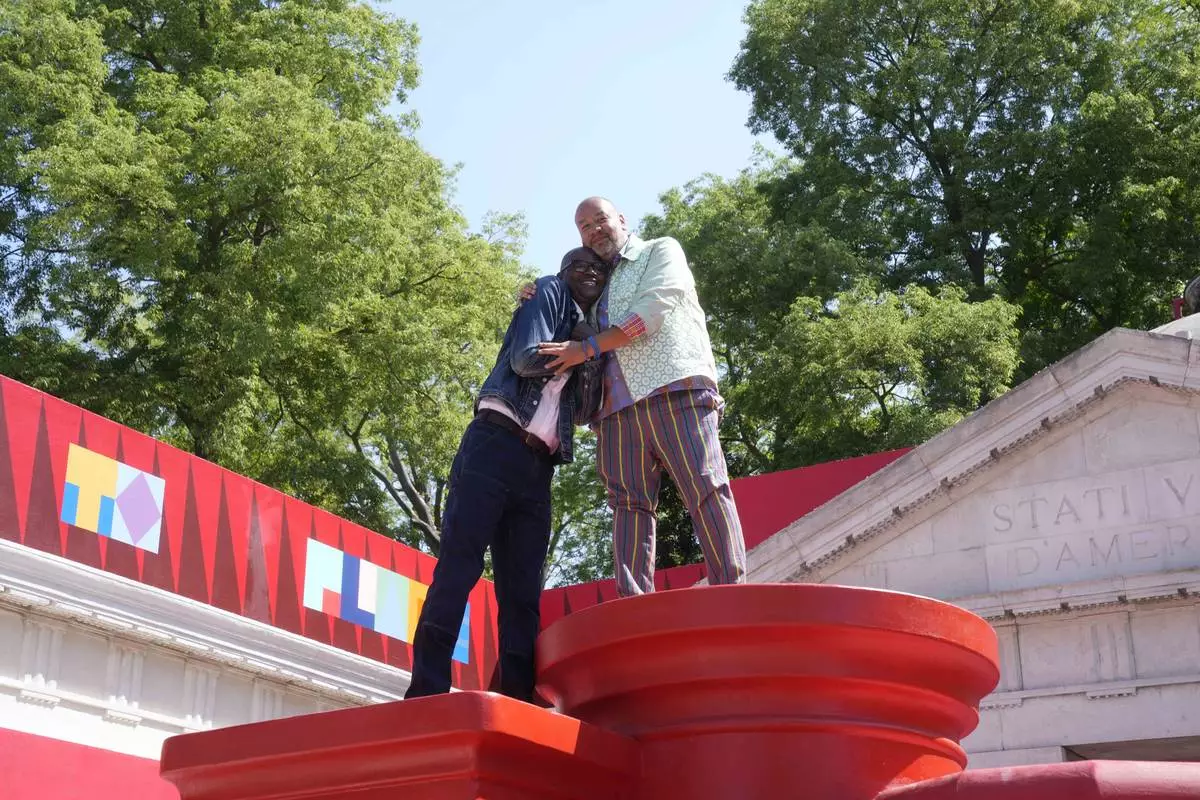
Artist Jeffrey Gibson, right, hugs artist Mark Bradford at the U.S. pavilion during media open day of the 60th Biennale of Arts exhibition in Venice, Italy, Tuesday, April 16, 2024. A Mississippi Choctaw of Cherokee descent, Gibson is the first Native American to represent the United States solo at the Venice Biennale, the world’s oldest contemporary art show. Gibson mixes Western modernism and Native American craft in his vibrantly hued paintings and sculptures. (AP Photo/Luca Bruno)
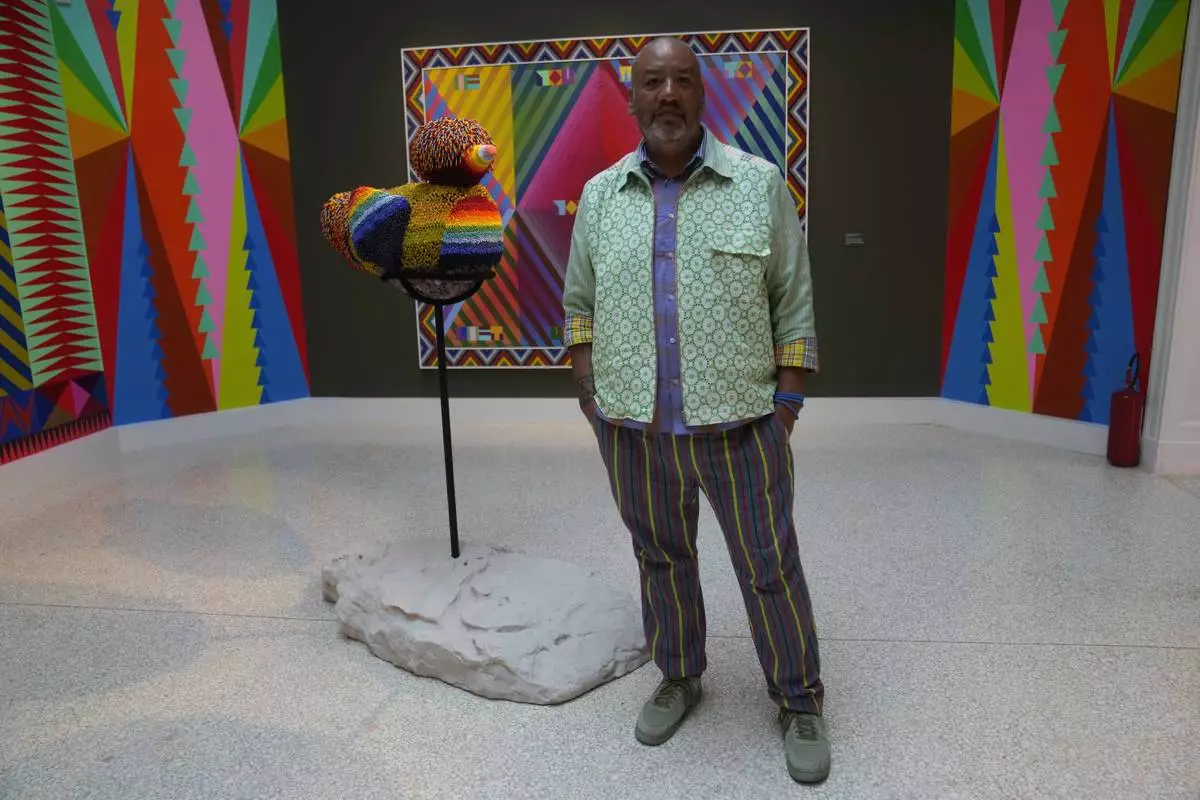
Artist Jeffrey Gibson poses inside the US pavilion during the media open day at the 60th Biennale of Arts in Venice, Italy, Tuesday, April 16, 2024. A Mississippi Choctaw of Cherokee descent, Gibson is the first Native American to represent the United States solo at the Venice Biennale, the world’s oldest contemporary art show. Gibson mixes Western modernism and Native American craft in his vibrantly hued paintings and sculptures. (AP Photo/Luca Bruno)




















